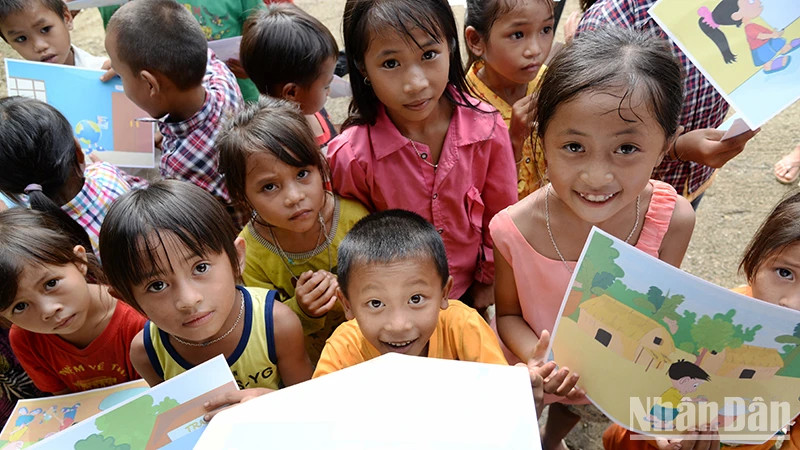Vietnam surpasses the 101 million mark from April 1, 2024
On January 6, 2025, the General Statistics Office announced the 2024 Mid-Term Population and Housing Census results.
The agency said that since 2019, although Vietnam's population growth rate has decreased due to a drop in fertility, the population size has remained stable, increasing by an average of nearly 1 million people per year. People's health has improved. The mortality rate of children under 1 year old and under 5 years old has decreased sharply. People's life expectancy continues to increase.
Information from the 2024 Mid-Term Population Census shows that as of April 1, 2024, Vietnam's population was 101,112,656 people. Vietnam is the third most populous country in Southeast Asia (after Indonesia and the Philippines) and the 16th in the world. After 5 years, from 2019 to now, Vietnam's population has increased by 4.9 million people. The average annual population growth rate in the 2019-2024 period is 0.99%/year, a decrease of 0.23 percentage points compared to the 2014-2019 period (1.22% per year).
As of April 1, 2024, Vietnam's population is 101,112,656 people. Vietnam is the third most populous country in Southeast Asia (after Indonesia and the Philippines) and the 16th in the world.
The country has 19 provinces with small populations under 1 million people, 37 provinces with populations from 1 to 2 million people and 7 provinces with populations over 2 million people. Hanoi and Ho Chi Minh City have the largest populations, with 8,685,607 people and 9,521,886 people, respectively.
The population gap between the most populous locality in the country (Ho Chi Minh City) and the least populous locality in the country (Bac Kan) is more than 29 times (Bac Kan's population is 328,609 people).
The country has more than 14.2 million people aged 60 and over
Vietnam is still in the "golden population structure" period, with one dependent for every two people of working age. Of which, the proportion of the population aged 15-64 accounted for 67.4% (down 0.6 percentage points compared to 2019), the proportion of the population under 15 years old accounted for 23.3% (down 1 percentage point compared to 2019) and the proportion of the population aged 65 and over accounted for 9.3% (up 1.6 percentage points compared to 2019).
It is forecasted that by 2030, the number of people aged 60 and over will be approximately 18 million, an increase of nearly 4 million compared to 2024.
The 2024 ageing index was 60.2%, an increase of 11.4 percentage points compared to 2019 and 16.9 percentage points compared to 2014.
The number of elderly people aged 60 and over is 14.2 million, an increase of 2.8 million people (equivalent to 1.25 times) compared to 2019 and an increase of 4.7 million people (equivalent to 1.5 times) compared to 2014.
It is forecasted that by 2030, the number of people aged 60 and over will be approximately 18 million people, an increase of nearly 4 million compared to 2024.
Vietnam's fertility rate shows signs of rapid decline
According to the National Statistics Agency, the total fertility rate (TFR) is 1.91 children per woman, below the replacement level in the last two years, 2023-2024, Vietnam's fertility has begun to show signs of decreasing more rapidly.
Specifically, from 2009 to the end of 2022, for nearly 15 years, Vietnam's fertility remained relatively stable around the replacement level. In 2023, Vietnam's TFR was 1.96 children per woman, and this figure continued to decrease to 1.91 children per woman in 2024.
The TFR of urban areas is 1.67 children per woman, lower than that of rural areas (2.08 children per woman). The statistical agency also pointed out significant differences in fertility between socio-economic regions in the country. The Northern midlands and mountains, the Red River Delta, and the Central Highlands are regions with high fertility rates, higher than the replacement fertility rate (2.34 children per woman, and 2.24 children per woman, respectively).
The two regions with low fertility rates and lower than the replacement fertility rate are the Southeast and the Mekong Delta (1.48 children per woman, and 1.62 children per woman, respectively).
The average life expectancy in 2024 nationwide is 74.7 years old. The life expectancy of men is 72.3 years old, and for women, it’s 77.3 years old. Compared to 2019, the average life expectancy at birth in Vietnam has increased by 1.1 years and the increase in life expectancy of men is higher than that of women, at 1.3 years and 1 year respectively.
The mid-term population and housing census at 0:00 on April 1, 2024, is the second mid-term population and housing census conducted in Vietnam after the first survey in 2014.
The purpose of the survey is to collect information on population and housing as a basis for assessing the implementation of the Socio-Economic Development Plan for the period 2021-2025 and develop policies, plan population and housing to serve the development of the Socio-Economic Development Plan for the period 2026-2030 and monitor the implementation of the United Nations Sustainable Development Goals to which the Vietnamese Government has committed.
The sampling survey has a large sample size of about 20% of the survey areas nationwide (equivalent to 39,340 survey areas). The sample is designed to ensure representation at the district level for population size indicators and the provincial level for the remaining indicators. At the same time, it collects basic information on population and demographics, population change (birth, death and migration), and housing and living conditions of households.
















